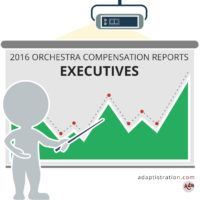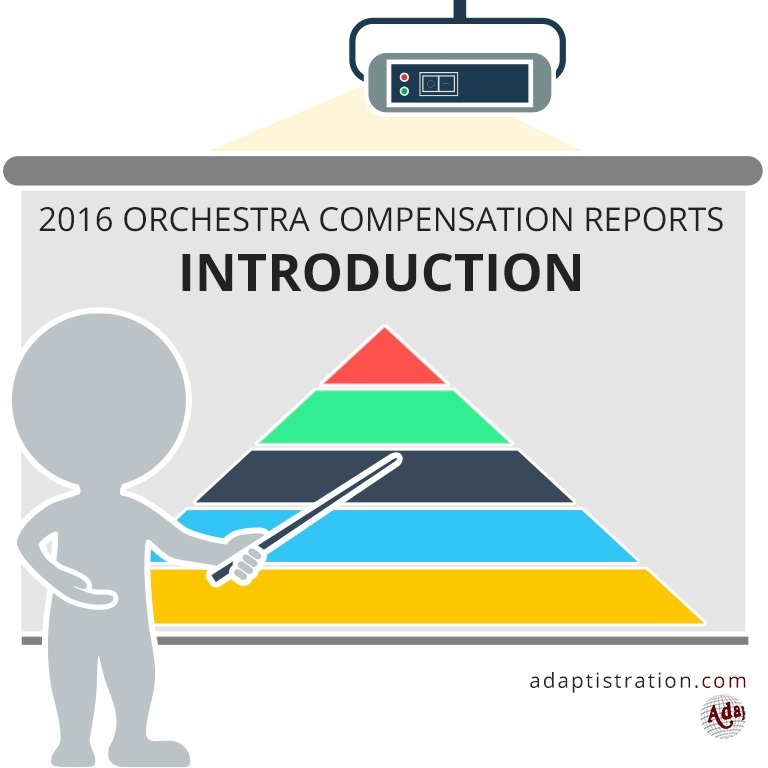When it comes to executive compensation, the 2013/14 season was the first in a while where a number of the traditionally highest paying executive positions which went unfilled for a number of years were finally occupied. As a result, this year’s reports produced a more realistic average compensation figure for this particular group of stakeholders. To that end, the average executive compensation increased at more than twice the rate of average total expenditures.
The Information
 In order to provide information that is as accurate as possible, info from the 2013/14 season is gathered from the following sources:
In order to provide information that is as accurate as possible, info from the 2013/14 season is gathered from the following sources:
- Executive compensation figures were obtained from their respective orchestra’s IRS Form 990 for the 2013/14 concert season.
- Total Expenditures were also obtained from each respective orchestra’s IRS Form 990 for the 2013/14 concert season (due to their relationship within a larger performing arts structure, Total Expenditure figures for National Symphony, Atlanta Symphony, and Dayton Philharmonic are estimates).
Adaptistration makes no claim to the accuracy of information from documents compiled or reported by external sources. If you have reason to believe any of the information is inaccurate or has changed since reported in any of the above sources and you can provide documentation to such effect, please feel free to use the following form to submit a notice.
What The Numbers Don’t Show
It is important to remember that the numbers shown do not always convey a complete compensation picture. For example, an executive director may have had a large increase in salary due to a severance or deferred compensation package owed when the position was vacated. Additionally, the documents used to gather data do not indicate how much of the season an individual received a salary. As such, the cumulative compensation may artificially inflate annual earnings. Conversely, reported figures may not reflect bonuses or other incentive payments, therefore underreporting what executives may actually earn. As such, the cumulative compensation executives may differ from what is listed.
If you’re curious about exactly how much of a difference can exist, the Philadelphia Orchestra bankruptcy proceeding shed a sliver of light onto the river of unspecified compensation executives can garner by way of perks and benefits. Details were reported in an article published on 3/2/2012.
For additional details about any individual executive’s compensation in any given season, you should review the corresponding IRS Form 990 for any statements, notes, and/or addendums provided by the organization to explain compensation abnormalities.
2013/14 Season Executive Compensation

Top 10 Earners
- Los Angeles Philharmonic: $1,586,820
- Boston Symphony: $852,607
- Philadelphia Orchestra: $733,242
- Cleveland Orchestra: $646,813
- Chicago Symphony: $633,619
- New York Philharmonic: $626,489
- San Francisco Symphony: $557,312
- Atlanta Symphony: $445,223
- Saint Louis Symphony: $443,541
- Minnesota Orchestra: $427,421
Items Of Note
The largest percent increases in executive compensation are always intriguing. For the second season in a row, Utah’s executive was at the top of the percent increase list with more than 20 percent in both seasons.
For example, the CEO’s in San Antonio, Milwaukee, Cincinnati, Dayton, and Utah all received increases in excess of twenty percent and all but two of those groups have turned over CEO’s since the 2012/13 season. The executives in Boston and Pittsburgh also managed to garner increases in excess of 20 percent. Executives at the Atlanta Symphony, Cincinnati Symphony, Houston Symphony, New York Philharmonic, Pacific Symphony, Rochester Philharmonic, San Diego Symphony, and Santa Rosa Symphony all managed to acquire between 10 and 20 percent increases.



Interesting that Philadelphia’s Vulgamore places third while her orchestra slaves are 7th? with contract bargaining talks mute despite the impending end of the current 1-year extension with a strike authorization (finally) in place. Yet, their fabulous quality and the trumpeting of YNS’s appointment to the MET and POA 10-year extension is all the news.
It’s also worth noting that this was the season where the orchestra approached the bankruptcy trustee to get the CEO compensation package, which restored the previous year’s shared-sacrifice cuts approved. Here’s the language about that action via their 2013/14 990 (Schedule J, Part III Supplemental Information):
DURING THIS FISCAL YEAR, MS VULGAMORE OPERATED UNDER AN EMPLOYMENT AGREEMENT (THE “CURRENT EMPLOYMENT AGREEMENT”) WITH THE PHILADELPHIA ORCHESTRA ASSOCIATION WHICH TERMINATES ON DECEMBER 31, 2014 THE CURRENT EMPLOYMENT AGREEMENT IS A MODIFICATION OF AN EMPLOYMENT AGREEMENT (THE “ORIGINAL EMPLOYMENT AGREEMENT”) DATED JANUARY 1, 2010 WHICH WAS IN EFFECT UNTIL DECEMBER 31, 2011 AND EXTENDED BY AGREEMENT WITH APPROVAL OF THE BANKRUPTCY COURT TO FEBRUARY 29, 2012 ON FEBRUARY 29, 2012, AN AMENDED AND RESTATED EMPLOYMENT AGREEMENT WAS FILED WITH THE BANKRUPTCY COURT WHICH ASSUMED THE ORIGINAL EMPLOYMENT AGREEMENT WITH CERTAIN MODIFICATIONS AND EXTENDED THE TERM TO DECEMBER 31, 2014 MS VULGAMORE ENTERED INTO A NEW EMPLOYMENT CONTRACT WITH THE PHILADELPHIA ORCHESTRA ASSOCIATION ON JANUARY 1, 2015
An additional column showing what percentage of the total budget the CEO compensation is. And, further, the change in that percentage from the year before. I would be interested to see what the industry average is, as a percentage.
That is something readers have asked for in previous reports but it doesn’t have as much applicable value across the variety of budget size institutions. Consequently, it projects a very apples to oranges comparison. Instead, the values listed provide what is needed to easily calculate those percentages but limited to peer comparison groups.
Philadelphia’s peer orchestras’ total budgets range from LA’s $117 million through Boston’s $88 million, Chicago’s $80 million, San Francisco’s $74 million, NY Phil’s $73 million to Cleveland’s $50 million. Philly comes in at a low-ball $45 million. Clearly, a great orchestra on the cheap!
I’m glad someone mentioned that. Philly’s overall total expenditures will be lower than many of their peers because they do not own and operate their primary venue. As such, those expenses do not appear as part of their financial structure. At the same time, it introduces an intriguing question of what should and should not constitute peer comparison values when setting executive compensation.
Neither does the NY Phil own Geffen Hall – they pay rent. Philly does own the Academy of Music and presumably collects rent from users while paying rent @ Verizon Hall.
How does a major donor to the Los Angeles Philharmonic justify a gift when so much money is “wasted” on Deborah Borda? What magic does she conjure to justify the $734,213 required in extra income and fundraising to cover her salary above that of the also very high salary of the BSO chief executive? How could that money be better spent by replacing her with another talented individual at half her salary? You have to wonder if the Board of Trustees of the Los Angeles Philharmonic truly acts in the best interest of that institution.
And considering the very existence of the Philadelphia Orchestra continues to be on the line, it seems, shouldn’t their chief executive accepting a lower salary?
Can we say that the Cleveland Orchestra continues to be a model of prudence and good sense paying its executive and music director at consistently more appropriate levels than many of their peer institutions?
The sorts of judgement based decisions you’re presenting are exactly what donors should arrive at after going through a thorough examination process when considering whether or not to make a donation.
The more an organization embraces transparency, the easier it is for donors and patrons to determine on their own whether compensation levels are justified.
A couple of points to make:
> These numbers are quite old due to the fact that 990 filings are filed at the last minute (which is 6 months after FY close).
> Even though it is apples to oranges, percentage would be useful to see what percentage of the budget goes to EDs and MDs. Just my opinion.
> Given that many of these orchestra musicians make six figures, then I don’t think that given the level of responsibility that these EDs have in terms of raising money, working with board members, working with artistic planning issues, etc. that their salary is out of line! Say a section string player makes $100K, then $600K for the ED (6 x scale wages) is not in my mind out of line. Not like the private sector where CEOs often make multiple times what the line worker makes when you factor in stock options and restricted stock.